Performance of Mortars Made Using Ternary Binders with Addition of Slag, Fly Ash and Limestone Exposed to a Real Environmental Condition Compatible with Exposure Class XC3
Abstract
:1. Introduction
2. Materials and Methods
2.1. Materials and Sample Preparation
2.2. Environmental Exposure Condition
2.3. Mercury Intrusion Porosimetry
2.4. Electrical Resistivity
2.5. Water Absorption
2.6. Steady-State Chloride Diffusion Coefficient
2.7. Carbonation Depth
2.8. Mechanical Strengths
2.9. Ultrasonic Pulse Velocity
3. Results
3.1. Mercury Intrusion Porosimetry
3.2. Electrical Resistivity
3.3. Water Absorption
3.4. Steady-State Chloride Diffusion Coefficient
3.5. Carbonation Front Depth
3.6. Mechanical Strengths
3.7. Ultrasonic Pulse Velocity
4. Discussion
4.1. Microstructure Characterization
4.2. Durability and Mechanical Parameters
5. Conclusions
- In the short term, the differences regarding the total porosity and the pore size distributions were not high between the studied mortars. Despite that, the pore network at 28 days was more refined for binary binders with slag and fly ash (S and F series) and for ternary binder which incorporate both additions (SF series). The presence of limestone in the binder overall reduced this pore refinement.
- A loss of microstructure refinement with time was noted for all the analyzed binders. This could be related to the development of carbonation process, due to the CO2 present in the environment, as well as by the possible formation of drying shrinkage microcracks in the long term caused by the lower environmental relative humidity.
- The slight differences between the studied binders regarding the water absorption after immersion would be influenced by the experimental procedure used for its determination, which would homogenize the effects of exposure environment in each binder.
- The carbonation front depths were higher for the analyzed binary and ternary binders in comparison with reference mortars. This was particularly noticeable for mortars with fly ash and limestone.
- The mechanical strengths hardly changed or even decreased with time depending on the binder, which would also be related to the harmful processes developed in the environment, such as carbonation and drying shrinkage. In addition, the ultrasonic pulse velocity results were compatible with the mechanical strength ones.
- The main novelty of this research was its analysis of the behavior of several mortars prepared with binary and ternary blended cements, which accomplished the prescriptions required for a standardized commercial cement type CEM II/B when they were exposed to environmental conditions compatible with the specifications of exposure class XC3, defined by Eurocode 2. In view of the results obtained, it is interesting to highlight that the binary and ternary binders with at least one active addition overall showed a higher pore refinement and lower steady-state chloride diffusion coefficient in the long term compared to reference mortars. In relation to the mechanical properties at later exposure times, the binary mortars with slag and fly ash (S and F series) and the ternary binder with both additions (SF series) showed the best mechanical performance, similar to reference mortars.
Author Contributions
Funding
Institutional Review Board Statement
Informed Consent Statement
Data Availability Statement
Acknowledgments
Conflicts of Interest
References
- Benhelal, E.; Shamsaei, E.; Rashid, M.I. Challenges against CO2 abatement strategies in cement industry: A review. J. Environ. Sci. 2021, 104, 84–101. [Google Scholar] [CrossRef]
- Ponikiewski, T.; Gołaszewski, J. The effect of high-calcium fly ash on selected properties of self-compacting concrete. Arch. Civ. Mech. Eng. 2014, 14, 455–465. [Google Scholar] [CrossRef]
- Hadji, T.; Guettala, S.; Quéneudec, M. Mix design of high performance concrete with different mineral additions. World J. Eng. 2021, 18, 767–779. [Google Scholar] [CrossRef]
- Mounanga, P.; Khokhar, M.I.A.; El Hachem, R.; Loukili, A. Improvement of the early-age reactivity of fly ash and blast furnace slag cementitious systems using limestone filler. Mater. Struct. Constr. 2011, 44, 437–453. [Google Scholar] [CrossRef]
- Yang, K.-H.; Jung, Y.-B.; Cho, M.-S.; Tae, S.-H. Effect of supplementary cementitious materials on reduction of CO2 emissions from concrete. J. Clean. Prod. 2015, 103, 774–783. [Google Scholar] [CrossRef]
- Puertas, F.; Barba, A.; Gazulla, M.F.; Gómez, M.P.; Palacios, M.; Martínez-Ramírez, S. Ceramic wastes as raw materials in portland cement clinker fabrication: Characterization and alkaline activation. Mater. Constr. 2006, 56, 73–84. [Google Scholar] [CrossRef] [Green Version]
- Bijen, J. Benefits of slag and fly ash. Constr. Build. Mater. 1996, 10, 309–314. [Google Scholar] [CrossRef]
- Faleschini, F.; Zanini, M.A.; Brunelli, K.; Pellegrino, C. Valorization of co-combustion fly ash in concrete production. Mater. Des. 2015, 85, 687–694. [Google Scholar] [CrossRef]
- Wang, A.; Zhang, C.; Sun, W. Fly ash effects. Cem. Concr. Res. 2004, 34, 2057–2060. [Google Scholar] [CrossRef]
- Schackow, A.; Stringari, D.; Senff, L.; Correia, S.L.; Segadães, A.M. Influence of fired clay brick waste additions on the durability of mortars. Cem. Concr. Compos. 2015, 62, 82–89. [Google Scholar] [CrossRef]
- Tang, W.C.; Wang, Z.; Liu, Y.; Cui, H.Z. Influence of red mud on fresh and hardened properties of self-compacting concrete. Constr. Build. Mater. 2018, 178, 288–300. [Google Scholar] [CrossRef]
- AENOR UNE-EN 197-1:2011. Composición, Especificaciones y Criterios de Conformidad de los Cementos Comunes; Asociación Española de Normalización y Certificación: Madrid, Spain, 2011. [Google Scholar]
- Wedding, P.; Manmohan, D.; Mehta, P. Influence of Pozzolanic, Slag, and Chemical Admixtures on Pore Size Distribution and Permeability of Hardened Cement Pastes. Cem. Concr. Aggreg. 1981, 3, 63. [Google Scholar] [CrossRef]
- Papadakis, V.G. Effect of fly ash on Portland cement systems. Cem. Concr. Res. 1999, 29, 1727–1736. [Google Scholar] [CrossRef]
- Hale, W.M.; Freyne, S.F.; Bush, T.D., Jr.; Russell, B.W. Properties of concrete mixtures containing slag cement and fly ash for use in transportation structures. Constr. Build. Mater. 2008, 22, 1990–2000. [Google Scholar] [CrossRef]
- Leng, F.; Feng, N.; Lu, X. An experimental study on the properties of resistance to diffusion of chloride ions of fly ash and blast furnace slag concrete. Cem. Concr. Res. 2000, 30, 989–992. [Google Scholar] [CrossRef]
- Nochaiya, T.; Wongkeo, W.; Chaipanich, A. Utilization of fly ash with silica fume and properties of Portland cement–fly ash–silica fume concrete. Fuel 2010, 89, 768–774. [Google Scholar] [CrossRef]
- Falaciński, P.; Machowska, A.; Szarek, Ł. The impact of chloride and sulphate aggressiveness on the microstructure and phase composition of fly ash-slag mortar. Materials 2021, 14, 4430. [Google Scholar] [CrossRef]
- Geiseler, J.; Kollo, H.; Lang, E. Influence of blast furnace cements on durability of concrete structures. ACI Mater. J. 1995, 92, 252–257. [Google Scholar]
- Thomas, M.D.A.; Scott, A.; Bremner, T.; Bilodeau, A.; Day, D. Performance of slag concrete in marine environment. ACI Mater. J. 2008, 105, 628–634. [Google Scholar]
- Pastor, J.L.; Ortega, J.M.; Flor, M.; López, M.P.; Sánchez, I.; Climent, M.A. Microstructure and durability of fly ash cement grouts for micropiles. Constr. Build. Mater. 2016, 117, 47–57. [Google Scholar] [CrossRef] [Green Version]
- Jain, J.A.; Neithalath, N. Chloride transport in fly ash and glass powder modified concretes—Influence of test methods on microstructure. Cem. Concr. Compos. 2010, 32, 148–156. [Google Scholar] [CrossRef]
- Kamali, M.; Ghahremaninezhad, A. An investigation into the hydration and microstructure of cement pastes modified with glass powders. Constr. Build. Mater. 2016, 112, 915–924. [Google Scholar] [CrossRef]
- Ortega, J.M.; Esteban, M.D.; Rodríguez, R.R.; Pastor, J.L.; Ibanco, F.J.; Sánchez, I.; Climent, M.A. Long-Term Behaviour of Fly Ash and Slag Cement Grouts for Micropiles Exposed to a Sulphate Aggressive Medium. Materials 2017, 10, 598. [Google Scholar] [CrossRef] [PubMed]
- Ortega, J.M.; Pastor, J.L.; Albaladejo, A.; Sánchez, I.; Climent, M.A. Durability and compressive strength of blast furnace slag-based cement grout for special geotechnical applications. Mater. Constr. 2014, 64, e003. [Google Scholar] [CrossRef] [Green Version]
- Dhandapani, Y.; Santhanam, M.; Kaladharan, G.; Ramanathan, S. Towards ternary binders involving limestone additions—A review. Cem. Concr. Res. 2021, 143, 106396. [Google Scholar] [CrossRef]
- Marchetti, G.; Irassar, E.F.; Rahhal, V.F. Effects of packing density and water film thickness on fresh and hardened properties of ternary cement pastes. Adv. Cem. Res. 2020, 32, 444–455. [Google Scholar] [CrossRef]
- Agrupación de Fabricantes de Cemento de España OFICEMEN. Available online: https://www.oficemen.com/ (accessed on 20 September 2021).
- Sanjuán, M.Á. Los cementos de adición en España del año 2000 al 2005. Cem. Hormigón 2007, 909, 4–55. [Google Scholar]
- Dadsetan, S.; Bai, J. Mechanical and microstructural properties of self-compacting concrete blended with metakaolin, ground granulated blast-furnace slag and fly ash. Constr. Build. Mater. 2017, 146, 658–667. [Google Scholar] [CrossRef]
- Ban, C.C.; Sern, L.J.; Jasme, N. The mechanical strength and drying shrinkage behavior of high performance concrete with blended mineral admixture. J. Teknol. 2019, 81, 59–67. [Google Scholar] [CrossRef] [Green Version]
- Radlinski, M.; Olek, J. Investigation into the synergistic effects in ternary cementitious systems containing portland cement, fly ash and silica fume. Cem. Concr. Compos. 2012, 34, 451–459. [Google Scholar] [CrossRef]
- De Weerdt, K.; Kjellsen, K.O.; Sellevold, E.; Justnes, H. Synergy between fly ash and limestone powder in ternary cements. Cem. Concr. Compos. 2011, 33, 30–38. [Google Scholar] [CrossRef]
- Cordeiro, G.C.; Toledo Filho, R.D.; Tavares, L.M.; Fairbairn, E.M.R. Experimental characterization of binary and ternary blended-cement concretes containing ultrafine residual rice husk and sugar cane bagasse ashes. Constr. Build. Mater. 2012, 29, 641–646. [Google Scholar] [CrossRef]
- Radwan, M.K.H.; Onn, C.C.; Mo, K.H.; Yap, S.P.; Ng, C.G.; Yusoff, S. Eco-mechanical performance of binary and ternary cement blends containing fly ash and slag. Proc. Inst. Civ. Eng. Eng. Sustain. 2020, 174, 23–36. [Google Scholar] [CrossRef]
- Bumanis, G.; Zorica, J.; Bajare, D. Properties of foamed lightweight high-performance phosphogypsum-based ternary system binder. Appl. Sci. 2020, 10, 6222. [Google Scholar] [CrossRef]
- Moffatt, E.G.; Thomas, M.D.A.; Fahim, A. Performance of high-volume fly ash concrete in marine environment. Cem. Concr. Res. 2017, 102, 127–135. [Google Scholar] [CrossRef]
- Detwiler, R.J.; Kjellsen, K.O.; Gjorv, O.E. Resistance to chloride intrusion of concrete cured at different temperatures. ACI Mater. J. 1991, 88, 19–24. [Google Scholar]
- Çakır, Ö.; Aköz, F. Effect of curing conditions on the mortars with and without GGBFS. Constr. Build. Mater. 2008, 22, 308–314. [Google Scholar] [CrossRef]
- Ramezanianpour, A.A.; Malhotra, V.M. Effect of curing on the compressive strength, resistance to chloride-ion penetration and porosity of concretes incorporating slag, fly ash or silica fume. Cem. Concr. Compos. 1995, 17, 125–133. [Google Scholar] [CrossRef]
- Shattaf, N.R.; Alshamsi, A.M.; Swamy, R.N. Curing/environment effect on pore structure of blended cement concrete. J. Mater. Civ. Eng. 2001, 13, 380–388. [Google Scholar] [CrossRef]
- Polder, R.B.; De Rooij, M.R. Durability of marine concrete structures—Field investigations and modelling. Heron 2005, 50, 133–154. [Google Scholar]
- Thomas, M.D.; Matthews, J. Performance of pfa concrete in a marine environment––10-year results. Cem. Concr. Compos. 2004, 26, 5–20. [Google Scholar] [CrossRef]
- Chalee, W.; Jaturapitakkul, C.; Chindaprasirt, P. Predicting the chloride penetration of fly ash concrete in seawater. Mar. Struct. 2009, 22, 341–353. [Google Scholar] [CrossRef]
- European Committee for Standardization. EN 1992-1-1 Eurocode 2: Design of Concrete Structures—Part 1-1: General Rules and Rules for Buildings; Committee European Normalization (CEN) Ed.: Brussels, Belgium, 2004. [Google Scholar]
- AENOR UNE-EN 196-1:2005. Métodos de Ensayo de Cementos. Parte 1: Determinación de Resistencias Mecánicas; Asociación Española de Normalización y Certificación: Madrid, Spain, 2005. [Google Scholar]
- Ortega, J.M.; Sánchez, I.; Cabeza, M.; Climent, M.A. Short-Term Behavior of Slag Concretes Exposed to a Real In Situ Mediterranean Climate Environment. Materials 2017, 10, 915. [Google Scholar] [CrossRef] [Green Version]
- Monaco, M.; Aurilio, M.; Tafuro, A.; Guadagnuolo, M. Sustainable mortars for application in the cultural heritage field. Materials 2021, 14, 598. [Google Scholar] [CrossRef]
- Ouellet, S.; Bussière, B.; Aubertin, M.; Benzaazoua, M. Microstructural evolution of cemented paste backfill: Mercury intrusion porosimetry test results. Cem. Concr. Res. 2007, 37, 1654–1665. [Google Scholar] [CrossRef]
- Horpibulsuk, S.; Rachan, R.; Chinkulkijniwat, A.; Raksachon, Y.; Suddeepong, A. Analysis of strength development in cement-stabilized silty clay from microstructural considerations. Constr. Build. Mater. 2010, 24, 2011–2021. [Google Scholar] [CrossRef]
- Olson, R.A.; Neubauer, C.M.; Jennings, H.M. Damage to the pore structure of hardened portland cement paste by mercury intrusion. J. Am. Ceram. Soc. 1997, 80, 2454–2458. [Google Scholar] [CrossRef]
- Pedeferri, P.; Bertolini, L. La Durabilità del Calcestruzzo Armato; Mc Graw-Hill Education: Milano, Italy, 2000; ISBN 9788838608452. [Google Scholar]
- Ho, L.S.; Nakarai, K.; Duc, M.; Kouby, A.L.; Maachi, A.; Sasaki, T. Analysis of strength development in cement-treated soils under different curing conditions through microstructural and chemical investigations. Constr. Build. Mater. 2018, 166, 634–646. [Google Scholar] [CrossRef]
- Polder, R.; Andrade, C.; Elsener, B.; Vennesland, Ø.; Gulikers, J.; Weidert, R.; Raupach, M. Test methods for on site measurement of resistivity of concrete. Mater. Struct. 2000, 33, 603–611. [Google Scholar] [CrossRef]
- Lübeck, A.; Gastaldini, A.L.G.; Barin, D.S.; Siqueira, H.C. Compressive strength and electrical properties of concrete with white Portland cement and blast-furnace slag. Cem. Concr. Compos. 2012, 34, 392–399. [Google Scholar] [CrossRef]
- AENOR UNE 83988-2:2014. Durabilidad del Hormigón. Métodos de Ensayo. Determinación de la Resistividad Eléctrica. Parte 2: Método de las Cuatro Puntas o de Wenner; Asociación Española de Normalización y Certificación: Madrid, Spain, 2014. [Google Scholar]
- Andrade, C.; Climent, M.A. Recomendaciones sobre determinación de la resistividad eléctrica del hormigón in situ mediante el método de las cuatro puntas y del disco; ALCONPAT Internacional: Mérida, Yucatán, Mexico, 2020; p. 11. [Google Scholar] [CrossRef]
- ASTM C642-06. Standard Test Method for Density, Absorption, and Voids in Hardened Concrete; ASTM International: West Conshohocken, PA, USA, 2006; p. 3. [Google Scholar]
- ASTM C1202-12. Standard Test Method for Electrical Indication of Concretes Ability to Resist Chloride Ion Penetration; ASTM International: West Conshohocken, PA, USA, 2012. [Google Scholar]
- Andrade, C.; Alonso, C.; Arteaga, A.; Tanner, P. Methodology based on the electrical resistivity for the calculation of reinforcement service life. In Proceedings of the 5th CANMET/ACI International Conference on Durability of Concrete, Supplementary Papers; Malhotra, V.M., Ed.; American Concrete Institute: Barcelona, Spain, 2000; pp. 899–915. [Google Scholar]
- DE LA RILEM RE. CPC-18 Measurement of hardened concrete carbonation depth. Mater. Struct. 1988, 21, 453–455. [Google Scholar] [CrossRef]
- AENOR UNE-EN 1015-11:1999. Métodos de Ensayo de los Morteros Para Albañilería. Parte 11: Determinación de la Resistencia a Flexión y a Compresión del Mortero Endurecido; Asociación Española de Normalización y Certificación: Madrid, Spain, 1999. [Google Scholar]
- Hong, G.; Oh, S.; Choi, S.; Chin, W.-J.; Kim, Y.-J.; Song, C. Correlation between the compressive strength and ultrasonic pulse velocity of cement mortars blended with silica fume: An analysis of microstructure and hydration kinetics. Materials 2021, 14, 2476. [Google Scholar] [CrossRef]
- AENOR UNE-EN 12504-4:2006. Ensayos de Hormigón en Estructuras. Parte 4: Determinación de la Velocidad de los Impulsos Ultrasónicos; Asociación Española de Normalización y Certificación: Madrid, Spain, 2006. [Google Scholar]
- Ortega, J.M.; Sánchez, I.; Climent, M.A. Impedance spectroscopy study of the effect of environmental conditions in the microstructure development of OPC and slag cement mortars. Arch. Civ. Mech. Eng. 2015, 15, 569–583. [Google Scholar] [CrossRef]
- Taylor, H.F.W. Cement Chemistry, 2nd ed.; Thomas Telford Publishing: London, UK, 1997; ISBN 978-0727725929. [Google Scholar]
- Neville, A.M. Properties of Concrete, 4th ed.; Pearson Education Limited: Harlow, UK, 1995. [Google Scholar]
- Shafiq, N.; Cabrera, J.G. Effects of initial curing condition on the fluid transport properties in OPC and fly ash blended cement concrete. Cem. Concr. Compos. 2004, 26, 381–387. [Google Scholar] [CrossRef]
- Ortega, J.M.; Sánchez, I.; Climent, M.A. Impedance spectroscopy study of the effect of environmental conditions on the microstructure development of sustainable fly ash cement mortars. Materials 2017, 10, 1130. [Google Scholar] [CrossRef] [PubMed] [Green Version]
- Bouikni, A.; Swamy, R.N.; Bali, A. Durability properties of concrete containing 50% and 65% slag. Constr. Build. Mater. 2009, 23, 2836–2845. [Google Scholar] [CrossRef]
- Meddah, M.S.; Lmbachiya, M.C.; Dhir, R.K. Potential use of binary and composite limestone cements in concrete production. Constr. Build. Mater. 2014, 58, 193–205. [Google Scholar] [CrossRef]
- Díaz, B.; Freire, L.; Nóvoa, X.R.; Pérez, M.C. Chloride and CO2 transport in cement paste containing red mud. Cem. Concr. Compos. 2015, 62, 178–186. [Google Scholar] [CrossRef]
- Kanna, V.; Olson, R.A.; Jennings, H.M. Effect of shrinkage and moisture content on the physical characteristics of blended cement mortars. Cem. Concr. Res. 1998, 28, 1467–1477. [Google Scholar] [CrossRef]
- Ma, B.-G.; Wen, X.-D.; Wang, M.-Y.; Yan, J.-J.; Gao, X.-J. Drying Shrinkage of Cement-Based Materials Under Conditions of Constant Temperature and Varying Humidity. J. China Univ. Min. Technol. 2007, 17, 428–431. [Google Scholar] [CrossRef]
- Anstice, D.J.; Page, C.L.; Page, M.M. The pore solution phase of carbonated cement pastes. Cem. Concr. Res. 2005, 35, 377–383. [Google Scholar] [CrossRef]
- Ngala, V.T.; Page, C.L. Effects of carbonation on pore structure and diffusional properties of hydrated cement pastes. Cem. Concr. Res. 1997, 27, 995–1007. [Google Scholar] [CrossRef]
- De Grazia, M.T.; Deda, H.; Sanchez, L.F.M. The influence of the binder type & aggregate nature on the electrical resistivity of conventional concrete. J. Build. Eng. 2021, 43, 102540. [Google Scholar] [CrossRef]
- Andrade, M.C.; Bolzoni, F.; Fullea, J. Analysis of the relation between water and resistivity isotherms in concrete. Mater. Corros. 2011, 62, 130–138. [Google Scholar] [CrossRef]
- Martínez-Molina, W.; Torres-Acosta, A.A.; Jáuregui, J.C.; Chávez-García, H.L.; Alonso-Guzmán, E.M.; Graff, M.; Arteaga-Arcos, J.C. Predicting concrete compressive strength and modulus of rupture using different NDT techniques. Adv. Mater. Sci. Eng. 2014, 2014, 742129. [Google Scholar] [CrossRef] [Green Version]
- Chindaprasirt, P.; Jaturapitakkul, C.; Sinsiri, T. Effect of fly ash fineness on compressive strength and pore size of blended cement paste. Cem. Concr. Compos. 2005, 27, 425–428. [Google Scholar] [CrossRef]
- Ortega, J.M.; Tremiño, R.M.; Sánchez, I.; Climent, M.Á. Effects of environment in the microstructure and properties of sustainable mortars with fly ash and slag after a 5-year exposure period. Sustainability 2018, 10, 663. [Google Scholar] [CrossRef] [Green Version]
- Atiş, C.D. Accelerated carbonation and testing of concrete made with fly ash. Constr. Build. Mater. 2003, 17, 147–152. [Google Scholar] [CrossRef]
- Khan, M.I.; Lynsdale, C.J. Strength, permeability, and carbonation of high-performance concrete. Cem. Concr. Res. 2002, 32, 123–131. [Google Scholar] [CrossRef]

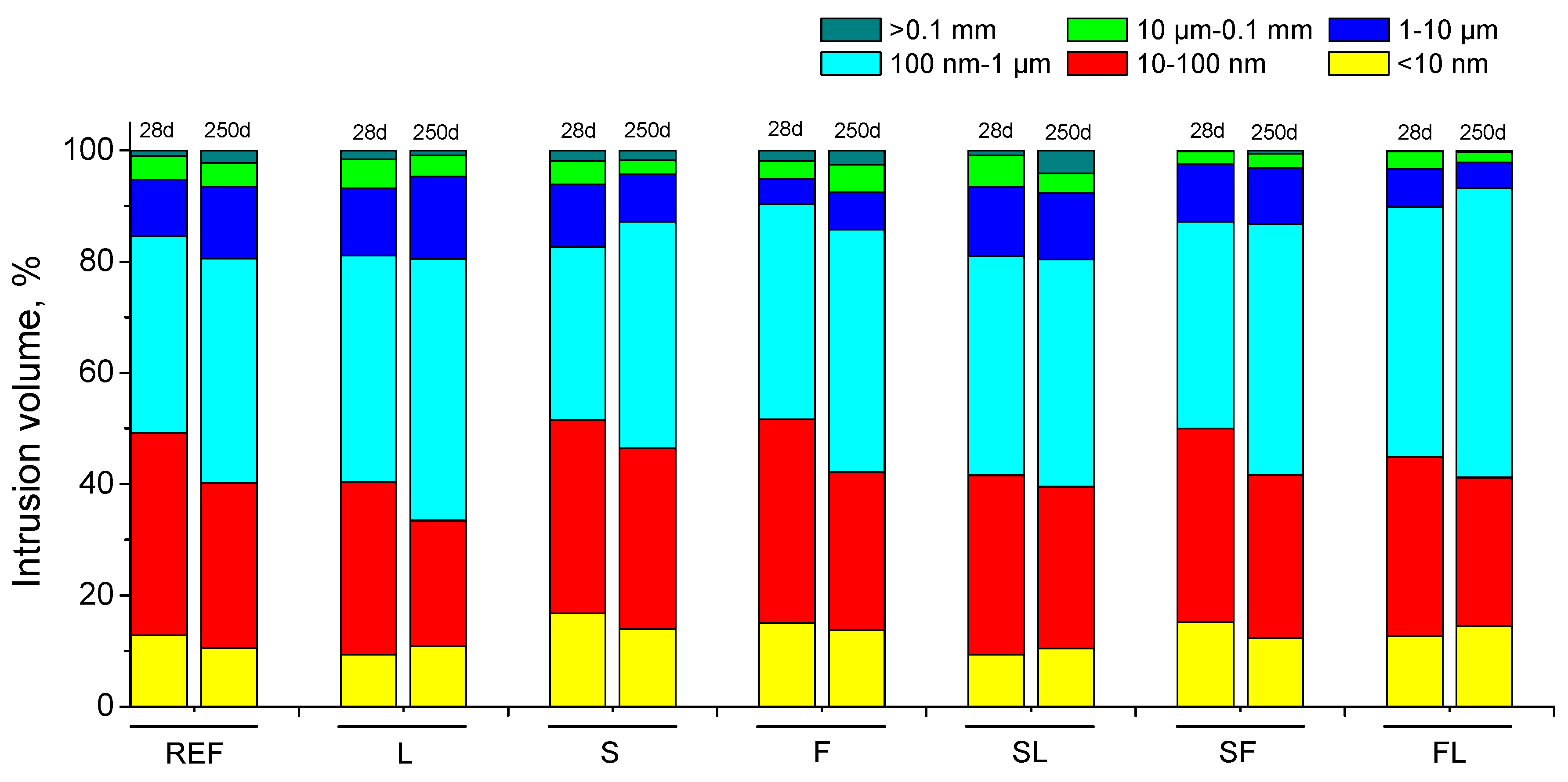
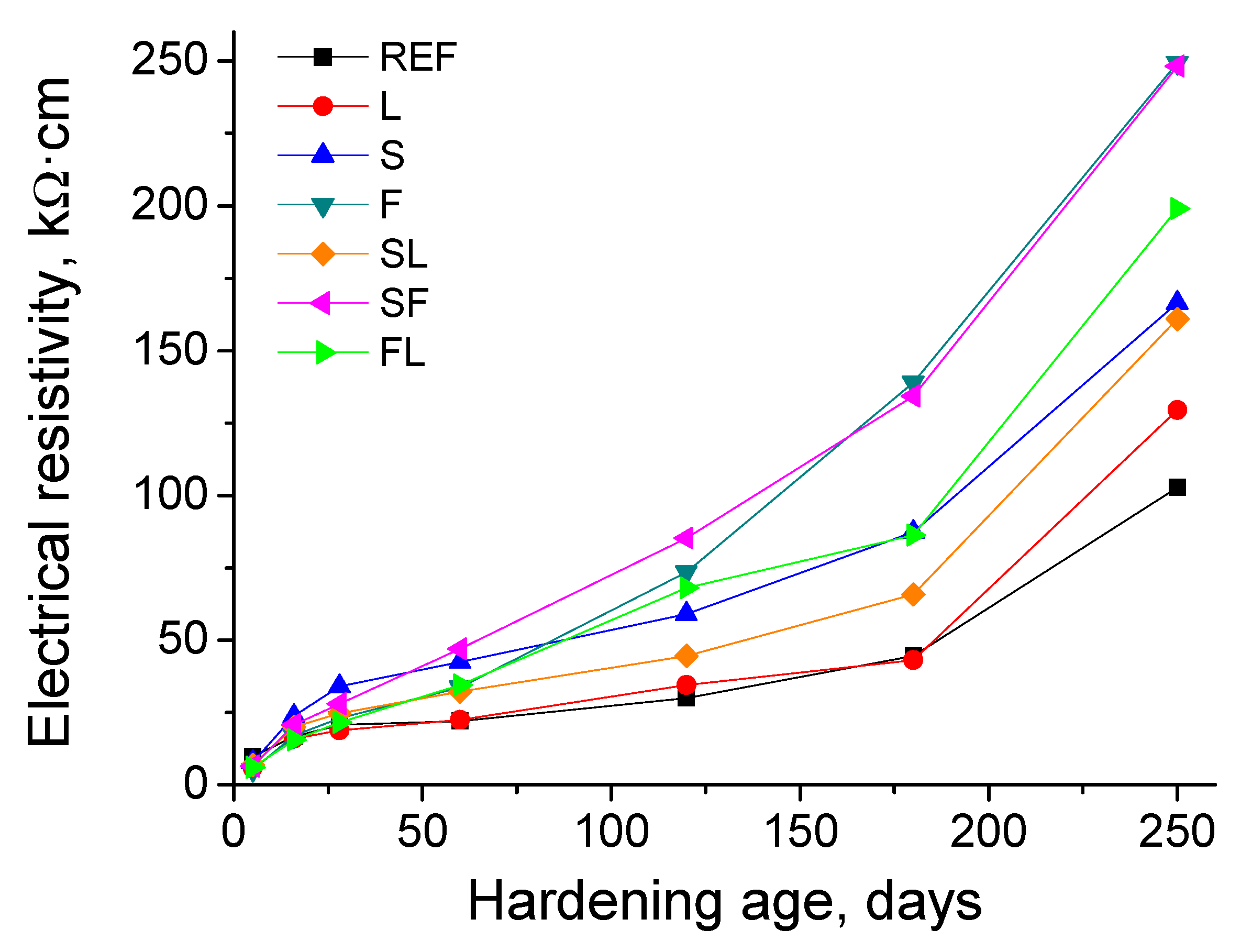
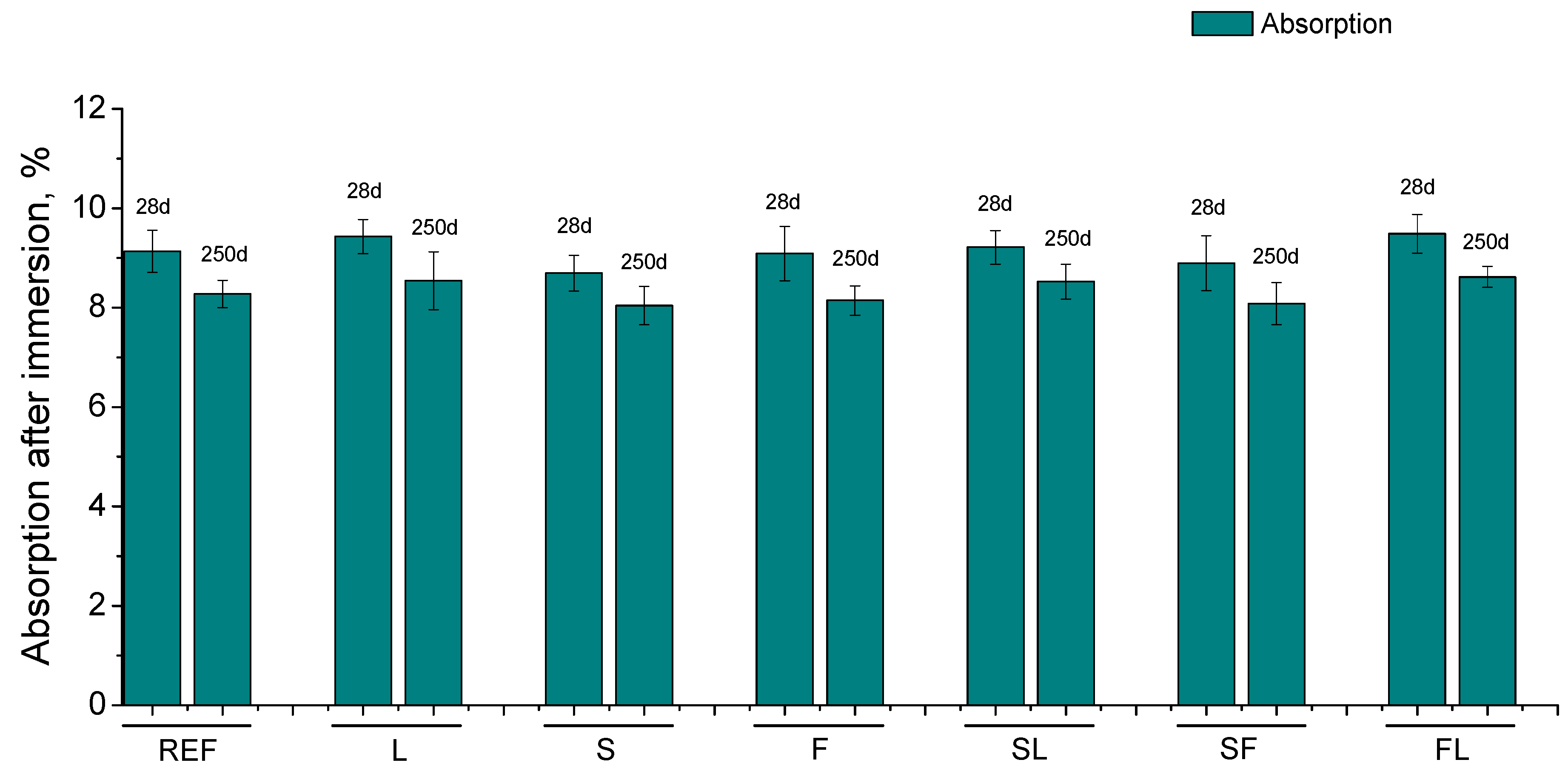

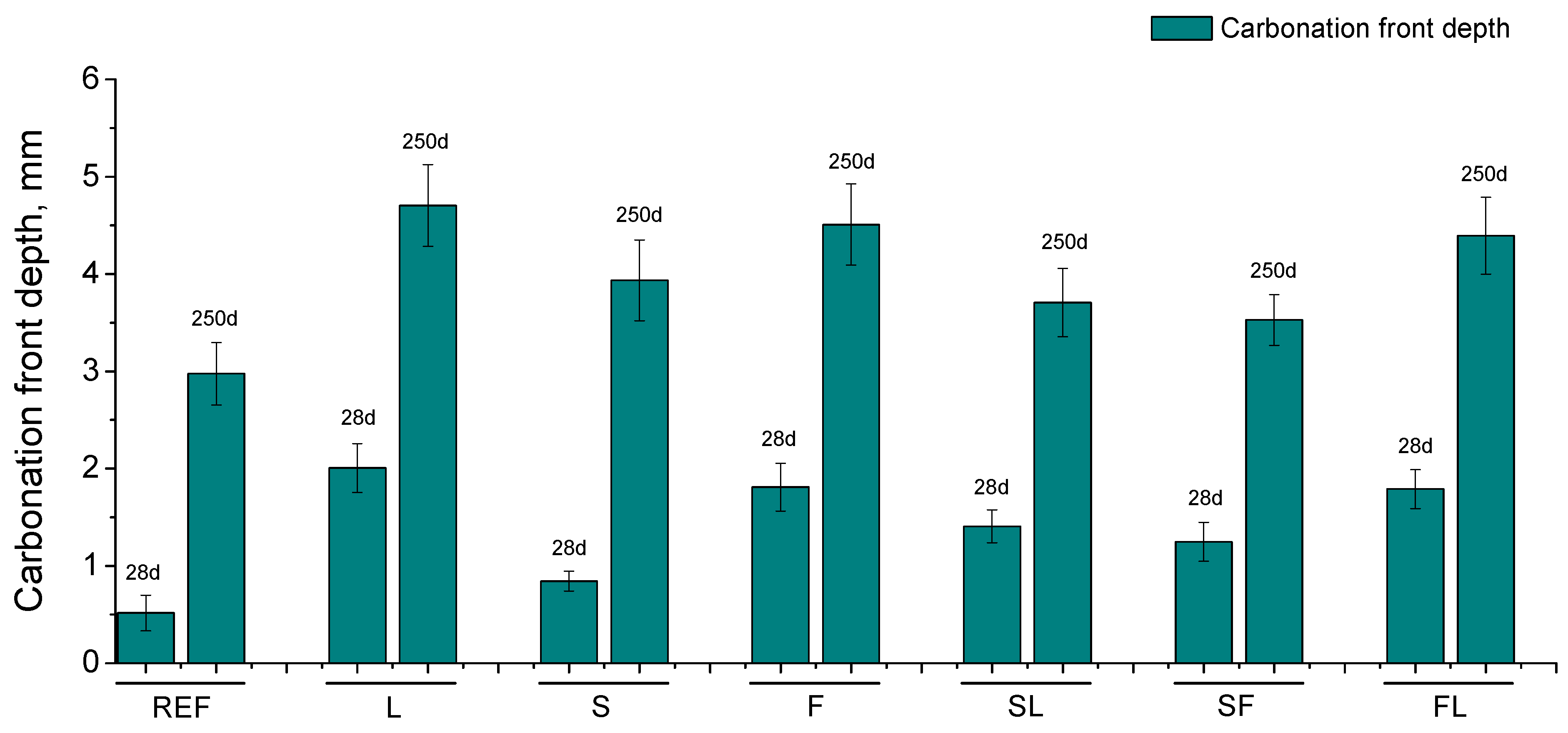
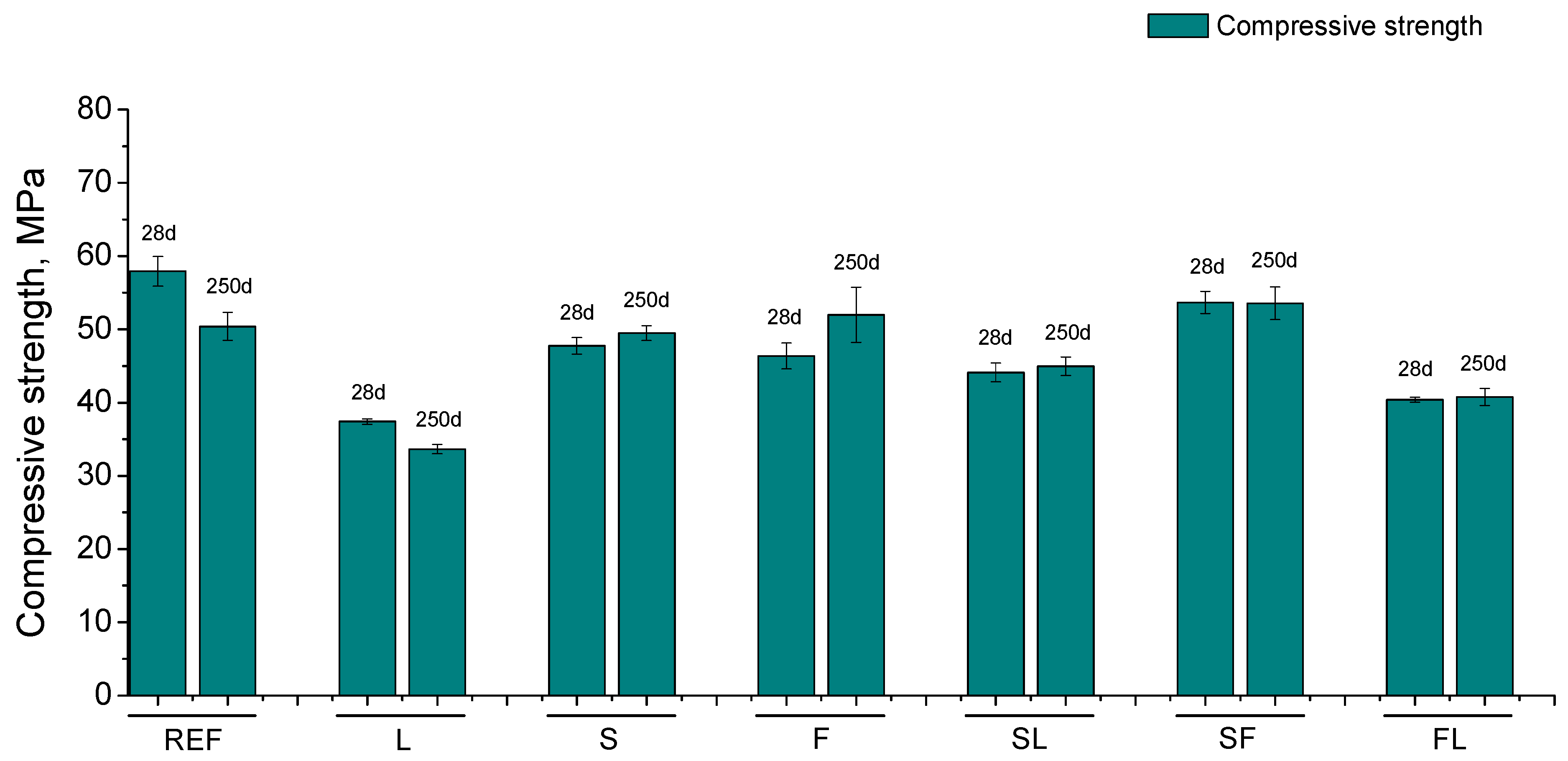


| Designation | CEM I 42.5 R | Blast Furnace Slag | Limestone | Fly Ash |
|---|---|---|---|---|
| REF | 100% | - | - | - |
| F | 70% | - | - | 30% |
| S | 70% | 30% | - | - |
| L | 70% | - | 30% | - |
| FL | 70% | - | 15% | 15% |
| SF | 70% | 15% | - | 15% |
| SL | 70% | 15% | 15% | - |
| Components | Fly Ash | Blast Furnace Slag | Limestone |
|---|---|---|---|
| SiO2 | 54.40% | 31.50% | 2.85% |
| MgO | 1.40% | 6.98% | 0.47% |
| K2O | 3.12% | 0.52% | 0.18% |
| Al2O3 | 27.70% | 10.10% | 1.22% |
| SO3 | 0.53% | 1.94% | 0.10% |
| TiO2 | 1.05% | 0.94% | 0.11% |
| Fe2O3 | 8.06% | 0.37% | 0.54% |
| CaO | 2.55% | 46.80% | 94.40% |
| P2O5 | 0.46% | 0.02% | 0.02% |
| ZnO | 0.11% | - | - |
| MnO | 0.06% | 0.17% | - |
| Na2O | - | 0.30% | - |
Publisher’s Note: MDPI stays neutral with regard to jurisdictional claims in published maps and institutional affiliations. |
© 2021 by the authors. Licensee MDPI, Basel, Switzerland. This article is an open access article distributed under the terms and conditions of the Creative Commons Attribution (CC BY) license (https://creativecommons.org/licenses/by/4.0/).
Share and Cite
Ibáñez-Gosálvez, J.; Real-Herraiz, T.; Ortega, J.M. Performance of Mortars Made Using Ternary Binders with Addition of Slag, Fly Ash and Limestone Exposed to a Real Environmental Condition Compatible with Exposure Class XC3. Materials 2021, 14, 5937. https://doi.org/10.3390/ma14205937
Ibáñez-Gosálvez J, Real-Herraiz T, Ortega JM. Performance of Mortars Made Using Ternary Binders with Addition of Slag, Fly Ash and Limestone Exposed to a Real Environmental Condition Compatible with Exposure Class XC3. Materials. 2021; 14(20):5937. https://doi.org/10.3390/ma14205937
Chicago/Turabian StyleIbáñez-Gosálvez, Javier, Teresa Real-Herraiz, and José Marcos Ortega. 2021. "Performance of Mortars Made Using Ternary Binders with Addition of Slag, Fly Ash and Limestone Exposed to a Real Environmental Condition Compatible with Exposure Class XC3" Materials 14, no. 20: 5937. https://doi.org/10.3390/ma14205937
APA StyleIbáñez-Gosálvez, J., Real-Herraiz, T., & Ortega, J. M. (2021). Performance of Mortars Made Using Ternary Binders with Addition of Slag, Fly Ash and Limestone Exposed to a Real Environmental Condition Compatible with Exposure Class XC3. Materials, 14(20), 5937. https://doi.org/10.3390/ma14205937








